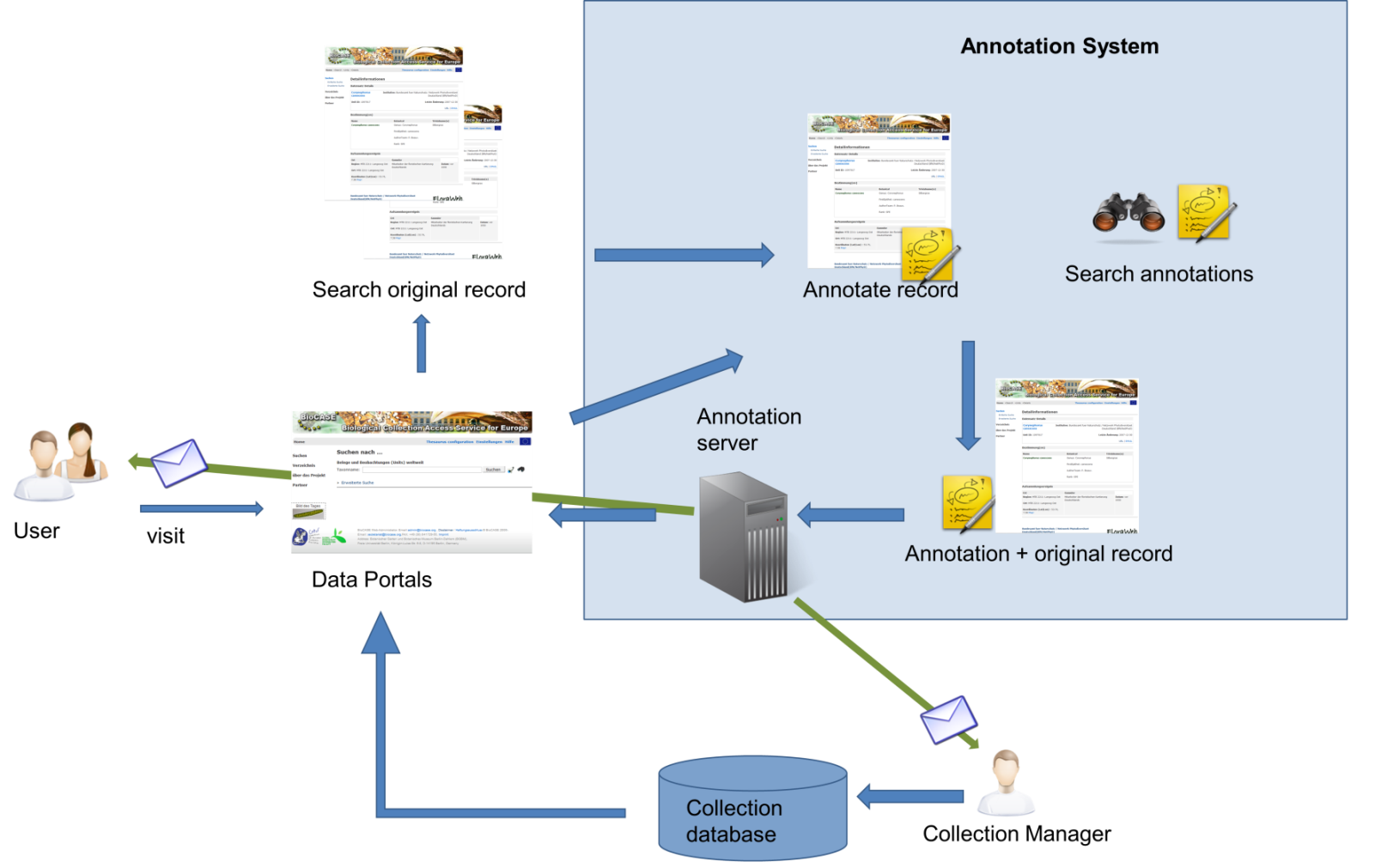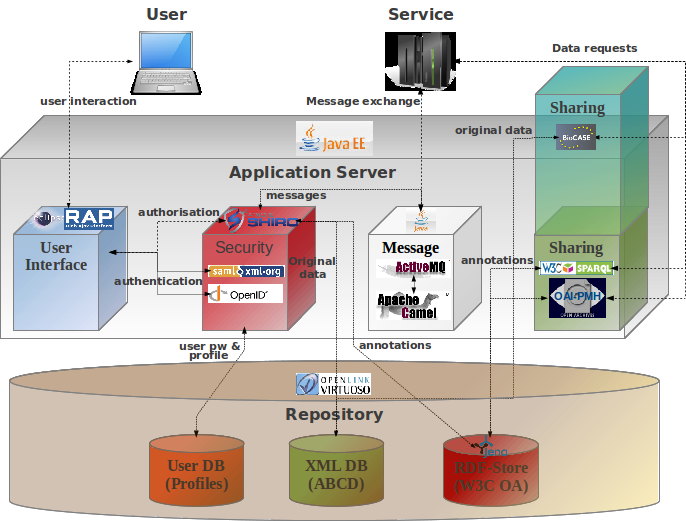Difference between revisions of "Main Page"
O.tschoepe (talk | contribs) (→The project) |
O.tschoepe (talk | contribs) (→The project) |
||
| Line 5: | Line 5: | ||
The AnnoSys system is available for public use since 2015 and increasingly incorporated in websites providing natural history specimen data. | The AnnoSys system is available for public use since 2015 and increasingly incorporated in websites providing natural history specimen data. | ||
| − | The project´s objective was to develop a publicly accessible annotation data repository for networked and highly complex biodiversity data. AnnoSys is based on a prototype developed in the context of SYNTHESYS and uses the Open Annotation Data Model and an RDF-database for storing the information. AnnoSys is implemented using the example of natural history collection data provided by several portals, most notably the Global Biodiversity Information Facility, GBIF [http://www.gbif.org/occurrence/search?basis_of_record=PRESERVED_SPECIMEN]. AnnoSys’ procedure of annotating records via the Internet is analogous to the traditional, written specimen annotation (e.g. a new taxonomic identification) found in natural history collections. However, it’s search and subscription capabilities make it possible to access or receive notification of annotations of records and even records of duplicate specimens accessed in different portals. | + | The project´s objective was to develop a publicly accessible annotation data repository for networked and highly complex biodiversity data. AnnoSys is based on a prototype developed in the context of [http://www.synthesys.info/ SYNTHESYS] and uses the Open Annotation Data Model and an RDF-database for storing the information. AnnoSys is implemented using the example of natural history collection data provided by several portals, most notably the Global Biodiversity Information Facility, GBIF [http://www.gbif.org/occurrence/search?basis_of_record=PRESERVED_SPECIMEN]. AnnoSys’ procedure of annotating records via the Internet is analogous to the traditional, written specimen annotation (e.g. a new taxonomic identification) found in natural history collections. However, it’s search and subscription capabilities make it possible to access or receive notification of annotations of records and even records of duplicate specimens accessed in different portals. |
Issues dealt with in the project include: | Issues dealt with in the project include: | ||
Revision as of 11:57, 22 August 2016
Contents
A generic annotation system for biodiversity data
The project
The AnnoSys system is available for public use since 2015 and increasingly incorporated in websites providing natural history specimen data.
The project´s objective was to develop a publicly accessible annotation data repository for networked and highly complex biodiversity data. AnnoSys is based on a prototype developed in the context of SYNTHESYS and uses the Open Annotation Data Model and an RDF-database for storing the information. AnnoSys is implemented using the example of natural history collection data provided by several portals, most notably the Global Biodiversity Information Facility, GBIF [1]. AnnoSys’ procedure of annotating records via the Internet is analogous to the traditional, written specimen annotation (e.g. a new taxonomic identification) found in natural history collections. However, it’s search and subscription capabilities make it possible to access or receive notification of annotations of records and even records of duplicate specimens accessed in different portals.
Issues dealt with in the project include: • categorisation of annotations • access rights, rights of personality, attribution of annotating scientists • quality checks • identifiers: reference and linking of annotations from various sources • schema independence for source data • feedback mechanisms for the distributed data providers (curatorial processes) • subscriptions, filtering of annotations, notification of users • user acceptance
AnnoSys-2 is a three-year project carried out at the Botanic Garden and Botanical Museum Berlin, funded by the LIS-Programme of the German Research Foundation (DFG). Original project title: “Internationalisierung und Realisierung des disziplin- und standardübergreifenden Anwendungspotentials des Online Annotationssystems - AnnoSys” (project number BE 2283/4-2).
The first project phase was a three-year project carried out at Botanic Garden and Botanical Museum Berlin, also funded by the LIS-Programme of the German Research Foundation (DFG). Original project title: “Ein generisches Annotationssystem für Biodiversitätsdaten” (project number BE 2283/4-1).
For further information visit AnnoSys
Overall architecture
Basic Workflow
The user visits the GBIF or the BioCase portal to access records. When wishing to annotate a record, he enters the annotation system and, after log in, conducts the annotation. The annotation is then saved on the annotation server together with the original record, both elements are connected via a GUID. The annotated version as well as the original record is then displayed to subsequent users on the data portal.
It is also possible to search for annotations via the annotation system, using specific criteria (e.g. a taxonomic group or a country). After an annotation has been conducted, a message system informs the collection manager about the changes in the record as well as users, who subscribed to the information service. The collection manager can then decide, whether he wants to adopt the annotation in his local database.
For further information visit AnnoSys
Main components
The Annotation System consists of the following components:
- Repository for annotations, annotated documents and user profiles
- Exchange of (Meta-)Data
- Message-System
- Graphical Interface
- Security (Authentication, Authorization)
Data Model
Annotation Data
We represent our annotation data as a list of data elements affected by modifications, the modified data element values within the dataset and/or comments added by the annotating agent. In consideration of the XML based nature of the envisioned dataset standard formats, elements of that list will at least consists of the following elements:
- Annotation context selection
- Value suggestion for the selected context elements
- Annotation type (e.g. new determination, typo correction, georeference)
- Free text comment referring to the selected context element(s)
- Annotator's motivation for making the proposal
- Evidence for the proposal given by the annotator
- Annotator's constraints (optional)
Annotation Meta Data
To complete the data model the following meta data are needed:
- Reference to
- the original object (GUID-Triple)
- the digital original document (GUID)
- the annotation (GUID on the basis of GUID of digital original document)
- Origin of original document (e.g. download-URL with date)
- Data format of original document (ABCD/Darwin core)
- Annotator (Name, Email, Institution)
- Annotation date
For further information visit AnnoSys
Publications
For a full publication record please visit AnnoSys[2]
- Tschöpe, O., Suhrbier, L., Güntsch, A. & Berendsohn, W.G. 2013: “AnnoSys: A generic annotation system for biodiversity data”. – BioSys. EU 2013 Global Systematics! 18.-22.2,2013, Vienna, Austria. Abstract Volume p. 219-220.
- Suhrbier, L., Tschöpe, O., Güntsch, A. & Berendsohn, W.G. 2012: “AnnoSys: A generic annotation system for biodiversity data”. - Biodiversity Information Standards (TDWG), TDWG Annual Conference, Bejing, China, October 22-26, 2012. Media:AnnoSys_TDWG_2012.pdf
- Tschöpe, O., Suhrbier, L., Güntsch, A. & Berendsohn, W.G. 2012: “A generic annotation system for biodiversity data”. - GEFD Tagung, Jahrestagung der Gesellschaft zur Erforschung der Flora Deutschlands e. V., 19.-21. Oct. 2012, Berlin, Germany.
- Tschöpe, O., Suhrbier, l., Güntsch, A. & Berendsohn, W.G. 2012: “A generic annotation system for biodiversity data” [Poster]. – "GBIF European Regional Nodes Meeting 2012“, 27.-29.3., Berlin.
- Tschöpe, O., Suhrbier, l., Güntsch, A. & Berendsohn, W.G. 2012: “AnnoSys: A generic annotation system for biodiversity data”. – "GBIF European Regional Nodes Meeting 2012“, 27.-29.3., Berlin. Media:AnnoSys_GBIF_nodes.pdf
People and Contact
Project staff
Walter Berendsohn - Principal Investigator
Anton Güntsch - Co-Investigator
Okka Tschöpe - Biologist
Lutz Suhrbier - Computer Scientist
contact: AnnoSys
Funding
The Annotation System project is funded by the Scientific Library Services and Information Systems (LIS) programme of the DFG ( LIS).

